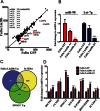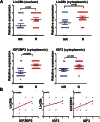Lin28b promotes head and neck cancer progression via modulation of the insulin-like growth factor survival pathway
- PMID: 23482325
- PMCID: PMC3681501
- DOI: 10.18632/oncotarget.785
Lin28b promotes head and neck cancer progression via modulation of the insulin-like growth factor survival pathway
Abstract
Lin28 is a developmentally regulated RNA binding protein which has recently emerged as key regulator in the biogenesis of the let-7 micro-RNA family. While the expression of Lin28b has been linked to advanced tumor stage, the precise molecular mechanism(s) by which Lin28b drives disease progression is still being unraveled. Herein, we generated a let-7-resistant Lin28b ORF, stably expressed in the FaDu head and neck cancer (HNC) cell line. FaDu-Lin28b cells exhibited enhanced tumor growth in vitro and in vivo. Global gene and micro-RNA expression analyses revealed significant enrichment in several pathways involved in cell migration, chromatin remodeling, and cellular stress response. Direct regulation of selected genes (HMGA2, CCND2, IGF1R, and IGF2BP2) via a let-7-Lin28b mechanism was validated. Notably, up-regulation of several genes in the IGF pathway in Lin28b-expressing cells was observed. Functional studies revealed significant increase in the survival of Lin28b-expressing cells when cultured under stress conditions, which was dependent on the presence of IGF1. Therefore, our data identified several novel gene targets for Lin28b-let7, and revealed a novel mechanism by which Lin28b promote tumorigenesis. Concordantly, clinical examinations of Lin28b, IGF2BP2 and IGF2 revealed a significant association between the expression of these genes with disease relapse, thereby corroborating the potential relevance for the Lin28b/IGF axis in HNC progression.
Figures





References
-
- Richards M, Tan SP, Tan JH, Chan WK, Bongso A. The transcriptome profile of human embryonic stem cells as defined by SAGE. Stem Cells. 2004;22(1):51–64. - PubMed
-
- Yu J, Vodyanik MA, Smuga-Otto K, Antosiewicz-Bourget J, Frane JL, Tian S, Nie J, Jonsdottir GA, Ruotti V, Stewart R, Slukvin, Thomson JA. Induced pluripotent stem cell lines derived from human somatic cells. Science. 2007;318(5858):1917–1920. - PubMed
-
- Heo I, Joo C, Cho J, Ha M, Han J, Kim VN. Lin28 mediates the terminal uridylation of let-7 precursor MicroRNA. Mol Cell. 2008;32(2):276–284. - PubMed
-
- Heo I, Joo C, Kim YK, Ha M, Yoon MJ, Cho J, Yeom KH, Han J, Kim VN. TUT4 in concert with Lin28 suppresses microRNA biogenesis through pre-microRNA uridylation. Cell. 2009;138(4):696–708. - PubMed
Publication types
MeSH terms
Substances
Grants and funding
LinkOut - more resources
Full Text Sources
Medical
Molecular Biology Databases
Research Materials
Miscellaneous

